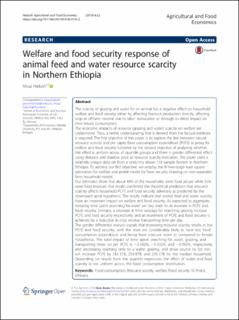| dc.description.abstract | The scarcity of grazing and water for an animal has a negative effect on household welfare and food security either by affecting livestock production directly, affecting crop or off-farm income due to labor reallocation or through its direct impact on time leisure consumption.
The economic impacts of resource (grazing and water) scarcity on welfare are undermined. Thus, a better understanding that is derived from the factual evidence is required. The first objective of this paper is to explore the link between natural resource scarcity and per capita food consumption expenditure (PCFE) as proxy for welfare and food security followed by the second objective of analyzing whether this effect is uniform across all quantile groups and there is gender differential effect using distance and shadow price as resource scarcity indicators. The paper used a relatively unique data set from a randomly drawn 518 sample farmers in Northern Ethiopia. To address our first objective, we employ the IV two-stage least square estimation for welfare and probit model for food security drawing on non-separable farm household model.
Our estimates show that about 48% of the households were food secure while 52% were food insecure. Our results confirmed the theoretical prediction that resource scarcity affects household PCFE and food security adversely as predicted by the downward spiral hypothesis. The results indicate that animal feed and water scarcity have an important impact on welfare and food security. As expected, in aggregate, reducing time spent searching for water per day leads to an increase in PCFE and food security. Similarly, a decrease in time wastage for searching grazing increase PCFE and food security respectively, and an increment of PCFE and food security is achieved by a reduction in crop residue transporting time per day.
The gender differential analysis signals that increasing resource scarcity results in low PCFE and food security, with the male are considerably likely to have less food consumption expenditure and being food insecure more as compared to female households. The total impact of time spent searching for water, grazing, and transporting straw on per PCFE is − 0.142%, − 0.102%, and − 0.092%, respectively, and decreasing reaching time to a water, grazing, and straw source by 0.6 min will increase PCFE by 354 ETB, 254 ETB, and 229 ETB for the median household. Depending on results from the quantile regression, the effect of water and feed scarcity is not uniform across the food consumption distribution. | en_US |

